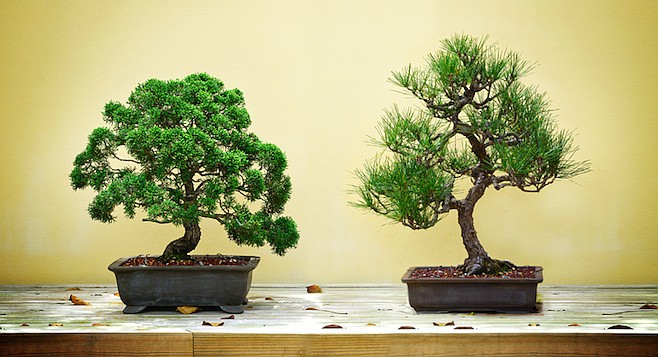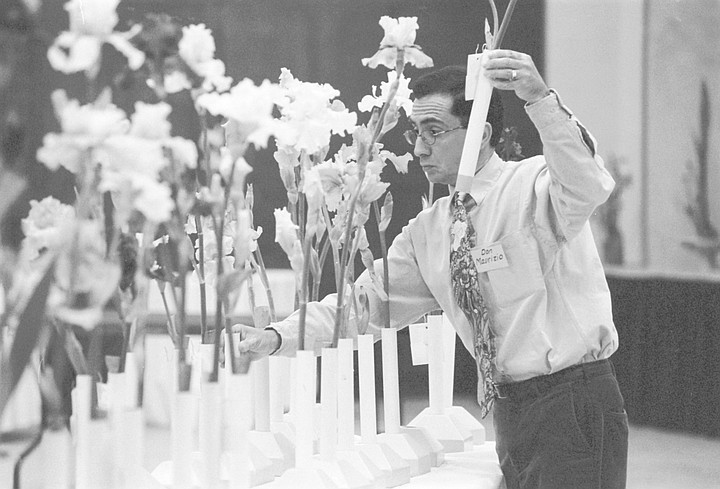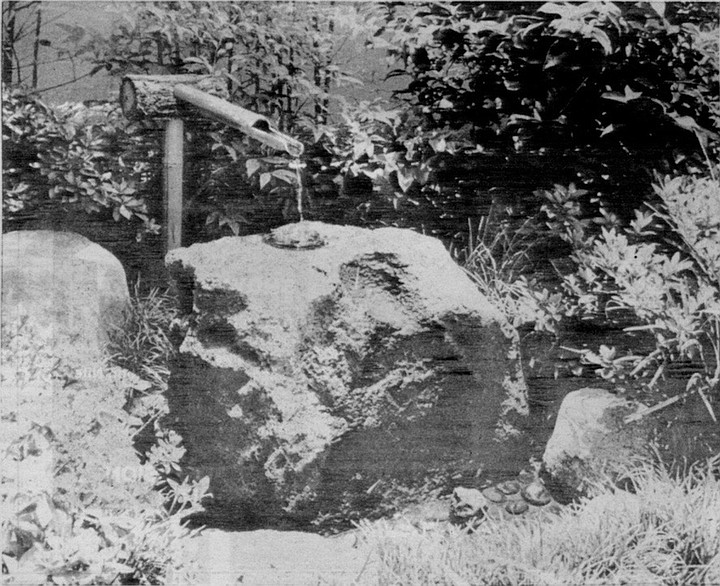 Facebook
Facebook
 X
X
 Instagram
Instagram
 TikTok
TikTok
 Youtube
Youtube

Most San Diegans, he explains, believe that the leafy, green and beige stuff that grows in their back yards, canyons, and along the San Diego River bed in Mission Valley is bamboo. But it’s not. “It’s Spanish reed,” he says, with some disdain. “Brought in by the Spaniards in, I believe, the 16th Century to use for thatching. Like some bamboos, it spreads rapidly by sending out runners, or rhizomes. But it’s not bamboo. True bamboo has branches, see?”
By Abe Opincar, Sept. 7, 1995 | Read full article

Some people may have been discouraged by experiences with would-be bonsai they bought at a chain store. Jackson isn’t surprised. “Those plants are mass-produced, all potted in the same kind of soil.” In reality, each species has its own requirements. Worse, many people don’t understand that bonsai are meant for outdoors. (Nor are they informed by the brief, accompanying instructions.) So they treat them as houseplants.”
By Jeanne Schinto, April 27, 2000 | Read full article

“What we want to see is a very sturdy stem, the bottom leaves not curled, and plenty of good, healthy leaves so the tomatoes won’t become sunburned. I was looking at my tomatoes with pleasure this morning because the plants look strong and healthy, the fruit is coming along, not ripening yet, but looking promising. And I brushed up against hem and set off that marvelous aroma that just seems to have in it the whole promise of summer.”
By Judith Moore, July 8, 1993 | Read full article

Dorothy had a floral display at Art Alive to worry about; one of the iris-show clerks backed out because her horse was due to foal; another flower show in Vista nabbed most of the National Council of State Garden Clubs judges, and the student judge she’d finally located wanted to enter a design; the key to the storage closet couldn’t be found; Buena Creek donated no spurias. But you didn’t see Dorothy Driscoll’s face mottled with rage and exasperation.
By Celia Storey, April 29, 1999 | Read full article

“I had an opportunity to look at some Japanese-style gardens here in California, but I couldn't really find a true Japanese garden. Most people, including some Japanese-American gardeners, believe that a Japanese garden simply has a Japanese stone lantern and a black pine and perhaps a carp pond. Now, a true Japanese garden does sometimes have these things, but they are not the whole garden. The idea of the Japanese garden is to create the beauty-point."
By Jeff Spurrier, Sept. 22, 1977 | Read full article

“About two Sundays ago I was going out to the garden by the big fern and when I got to the corner I heard a voice say, ‘Oh, look mom, look!’ Well, I looked, and my God, there was a man swinging in that beautiful fern. He’d taken hold of a bunch of fernery and was swinging with it. I tell you, I was really bruised; I just couldn’t imagine anyone being so damn stupid!"”
By Sean Rafferty, July 20, 1978 | Read full article


Most San Diegans, he explains, believe that the leafy, green and beige stuff that grows in their back yards, canyons, and along the San Diego River bed in Mission Valley is bamboo. But it’s not. “It’s Spanish reed,” he says, with some disdain. “Brought in by the Spaniards in, I believe, the 16th Century to use for thatching. Like some bamboos, it spreads rapidly by sending out runners, or rhizomes. But it’s not bamboo. True bamboo has branches, see?”
By Abe Opincar, Sept. 7, 1995 | Read full article

Some people may have been discouraged by experiences with would-be bonsai they bought at a chain store. Jackson isn’t surprised. “Those plants are mass-produced, all potted in the same kind of soil.” In reality, each species has its own requirements. Worse, many people don’t understand that bonsai are meant for outdoors. (Nor are they informed by the brief, accompanying instructions.) So they treat them as houseplants.”
By Jeanne Schinto, April 27, 2000 | Read full article

“What we want to see is a very sturdy stem, the bottom leaves not curled, and plenty of good, healthy leaves so the tomatoes won’t become sunburned. I was looking at my tomatoes with pleasure this morning because the plants look strong and healthy, the fruit is coming along, not ripening yet, but looking promising. And I brushed up against hem and set off that marvelous aroma that just seems to have in it the whole promise of summer.”
By Judith Moore, July 8, 1993 | Read full article

Dorothy had a floral display at Art Alive to worry about; one of the iris-show clerks backed out because her horse was due to foal; another flower show in Vista nabbed most of the National Council of State Garden Clubs judges, and the student judge she’d finally located wanted to enter a design; the key to the storage closet couldn’t be found; Buena Creek donated no spurias. But you didn’t see Dorothy Driscoll’s face mottled with rage and exasperation.
By Celia Storey, April 29, 1999 | Read full article

“I had an opportunity to look at some Japanese-style gardens here in California, but I couldn't really find a true Japanese garden. Most people, including some Japanese-American gardeners, believe that a Japanese garden simply has a Japanese stone lantern and a black pine and perhaps a carp pond. Now, a true Japanese garden does sometimes have these things, but they are not the whole garden. The idea of the Japanese garden is to create the beauty-point."
By Jeff Spurrier, Sept. 22, 1977 | Read full article

“About two Sundays ago I was going out to the garden by the big fern and when I got to the corner I heard a voice say, ‘Oh, look mom, look!’ Well, I looked, and my God, there was a man swinging in that beautiful fern. He’d taken hold of a bunch of fernery and was swinging with it. I tell you, I was really bruised; I just couldn’t imagine anyone being so damn stupid!"”
By Sean Rafferty, July 20, 1978 | Read full article
Comments